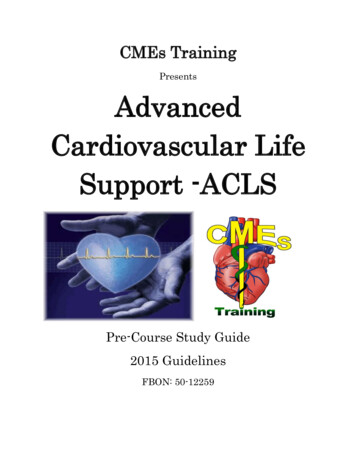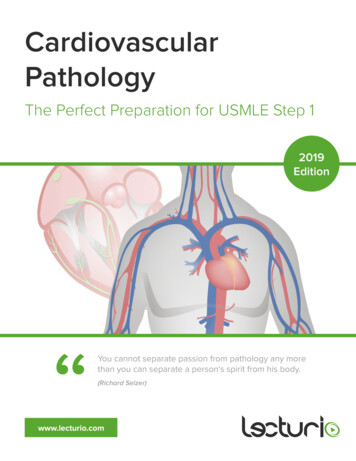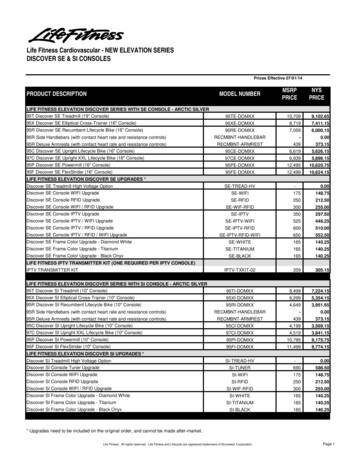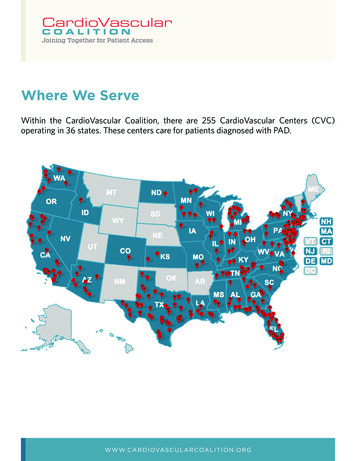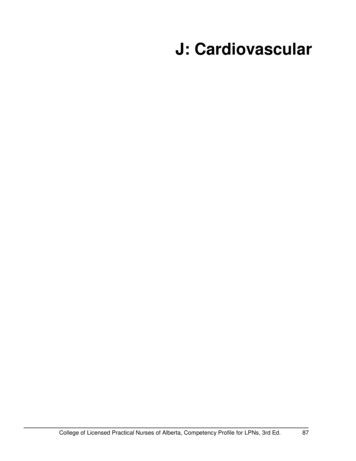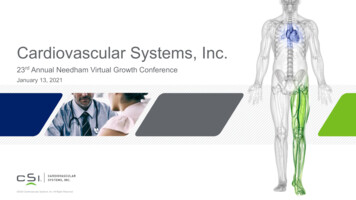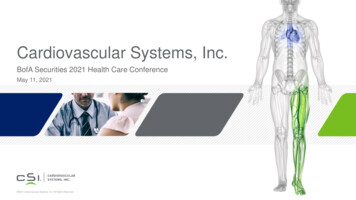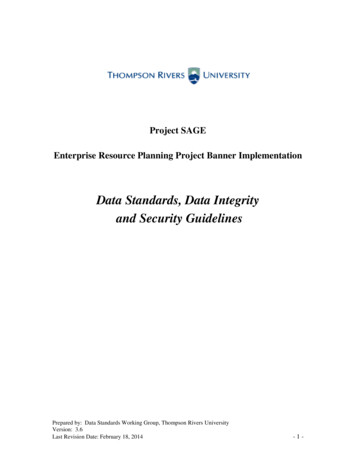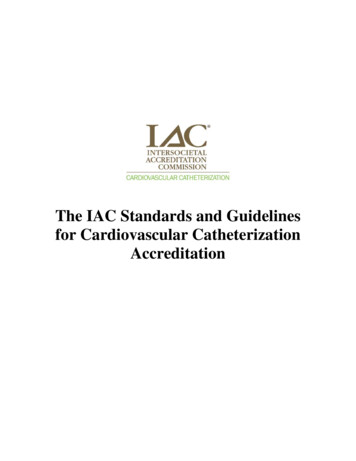
Transcription
The IAC Standards and Guidelinesfor Cardiovascular CatheterizationAccreditation
Table of ContentsAll entries in Table of Contents are linked to the corresponding sections.Introduction . 3Part A: Organization . 4Section 1A: Personnel and Supervision . 4STANDARD – Medical Director . 4STANDARD – Medical Staff . 6STANDARD – Nurse Manager . 8STANDARD – Technical Manager . 10STANDARD – Nursing Staff. 11STANDARD – Technical Staff . 13STANDARD – Advanced Practice Providers . 15STANDARD – Ancillary Personnel . 17STANDARD – Anesthesia Personnel . 18STANDARD – Medical Physicist . 18Section 1A: Personnel and Supervision Guidelines. 20Section 2A: Facility . 21STANDARD – Examination Areas. 21STANDARD – Interpretation Areas . 25STANDARD – Storage Space . 25STANDARD – Equipment and Instrumentation . 26STANDARD – Equipment and Instrumentation Quality Control . 29STANDARD – Quality Control Documentation . 30Section 2A: Facility Guidelines . 31Section 3A: Administrative. 32STANDARD – Patient Confidentiality . 32STANDARD – Patient or Other Customer Complaints . 32STANDARD – Primary Source Verification . 32Section 3A: Administrative Guidelines . 33Part B: Process . 34Section 1B: Procedures and Protocols . 34STANDARD – Procedure Overview . 34STANDARD – Procedure Requirements . 34STANDARD – Procedure Interpretation and Reports. 38STANDARD – Procedure Volumes . 63Section 1B: Procedures and Protocols Guidelines. 64Part C: Quality Improvement . 69Section 1C: Quality Improvement . 69STANDARD – Quality Improvement (QI) Program. 69STANDARD – QI Oversight . 69Section 1C: Quality Improvement Meetings Guidelines . 70Section 2C: Quality Improvement Measures . 71STANDARD – Test Appropriateness . 71STANDARD – Technical Quality Review. 71STANDARD – Safety and Procedural Outcomes . 71STANDARD – Interpretive Quality Review . 72STANDARD – Final Report Completeness and Timeliness . 72Section 2C: Quality Improvement Measures Guidelines. 73Section 3C: Quality Improvement Meetings . 74STANDARD – QI Meetings . 74Section 4C: Quality Improvement Documentation/ Record Retention . 75STANDARD – QI Documentation / Record Retention . 75Selected Bibliography . 76Appendix A . 81Appendix B . 86Structural Heart Interventions: Qualifying Procedure Types. 86Complex ACHD: Qualifying Procedure Types . 86Appendix C . 88IAC Standards and Guidelines for Cardiovascular Catheterization Accreditation (Published 8/15/2018) 2018 Intersocietal Accreditation Commission. All Rights Reserved.2
IntroductionThe Intersocietal Accreditation Commission (IAC) is a non-profit organization that accredits facilities that perform adultand/or pediatric diagnostic and/or interventional cardiovascular catheterization procedures. Accreditation in cardiovascularcatheterization may include one or more of the following testing areas: adult diagnostic catheterization, percutaneouscoronary invention (PCI), valve interventions, structural heart interventions, complex adult congenital heart disease(ACHD), pediatric cardiovascular catheterization. IAC accreditation is a means by which facilities can evaluate anddemonstrate the level of patient care they provide. The IAC program for accreditation in cardiovascular catheterization isdedicated to ensuring quality patient care and promoting health care and support through one common mission: Improvinghealth care through accreditation .This program is designed to accredit facilities that perform cardiovascular catheterization procedures by ensuring that thefacility meets benchmarks for quality based on resources, training and outcomes. Cardiovascular catheterizationprocedures may be appropriately performed for many indications related to the diagnosis and treatment of acquired andcongenital diseases of the heart.1,2,3 The outcome benchmarks used in this program are intended to be applied only to casestreated for indications related to cardiovascular catheterization. A facility that meets the outcome benchmarks for thesemost common indications will most likely provide adequate outcomes for cardiovascular catheterization proceduresperformed for less common indications.A facility performing cardiovascular catheterization procedures must provide the appropriately credentialed staff,equipment, policies and procedures. All personnel using equipment associated with cardiovascular catheterization must beable to demonstrate familiarity and proficiency with the setup, operation and characteristics of the equipment employed attheir site. Additionally, a facility performing cardiovascular catheterization procedures that routinely require theperformance of transesophageal echocardiography, must do so in an IAC Echocardiography accredited facility.Each facility must have a Medical Director and a Nurse Manager and/or Technical Manager. The facility may becomprised of dedicated and/or shared equipment and personnel resources (e.g., a dedicated cardiovascular catheterizationlaboratory and personnel, an interventional laboratory with shared equipment and personnel, a hybrid OR with dedicatedand/or shared equipment and personnel, etc.). The facility must meet the organizational requirements defined in thisdocument. The designation of the title of Medical Director, Nurse Manager and Technical Manager are for IACaccreditation purposes only. Those assigned in these roles for the purpose of accreditation must meet the training andexperience requirements as outlined in the IAC Standards, but may also have oversight or dual responsibilities for otherprocedures other than those directly related to cardiovascular catheterization procedures. When more than one technicalmember is employed, the Technical Manager and/or Nurse Manager are responsible for supervision of the technical staff.If cardiovascular catheterization procedures are performed in more than one location within one facility, the facility isencouraged to apply for all locations within that facility under the overall direction of a Medical Director(s). All operators[i.e., physician(s), advanced practice provider (s), nurse(s) and technologists(s)] and all cases under the direction of theMedical Director(s) must be included in the application for accreditation.The intent of the accreditation process is two-fold. It is designed to recognize facilities that provide quality services forcardiovascular catheterization procedures. It is also designed to be used as an educational tool to improve the overallquality of the facility.These accreditation Standards and Guidelines are the minimum standards for accreditation of facilities performingcardiovascular catheterization procedures. Standards are the minimum requirements to which an accredited facility is heldaccountable. Guidelines are descriptions, examples, or recommendations that elaborate on the Standards. Guidelines arenot required, but can assist with interpretation of the Standards.Standards are printed in regular typeface in outline form. Guidelines are printed in italic typeface in narrative form.Standards that are highlighted are content changes that were made as part of the August 15, 2018 revision.Facilities applying for accreditation after August 15, 2018 must comply with these new highlighted Standards.In addition to all Standards listed in this document, the facility, including all staff, must comply at all times with allfederal, state and local laws and regulations, including but not limited to laws relating to licensed scope of practice, facilityoperations and billing requirements.IAC Standards and Guidelines for Cardiovascular Catheterization Accreditation (Published 8/15/2018) 2018 Intersocietal Accreditation Commission. All Rights Reserved.Return to Table of Contents»3
Part A:OrganizationSection 1A: Personnel and SupervisionSTANDARD – Medical Director1.1AThe Medical Director must be a licensed physician.1.1.1AMedical Director Required Training and ExperienceThe Medical Director must demonstrate an appropriate level of training and experience bymeeting one or more of the following:1.1.1.1ABoard certified in his/her specialty:i.1.1.1.2AFor diagnostic cardiovascular catheterization, board certified in his/her specialty:i.1.1.1.3ALevel III training in cardiac catheterization.4,5For pediatric cardiovascular catheterization, board certified in his/her specialty:9,16,25i.ii.iii.1.1.1.5ALevel II training in cardiac catheterization.4,5For interventional cardiovascular catheterization, board certified in his/her specialty:i.1.1.1.4AInitial certification by the American Board of Internal Medicine (ABIM) ininterventional cardiology or the American Osteopathic Board of InternalMedicine (AOBIM) in interventional cardiology.certification by the American Board of Pediatrics (ABP) in pediatriccardiology, by the Royal College of Physicians and Surgeons of Canada inpediatric cardiology, or by the American Board of Internal Medicine(ABIM) in adult congenital heart disease;additional training in pediatric cardiac catheterization and intervention(beyond what is typically obtained in categorical fellowship) or completionof pediatric cardiology fellowship prior to 2000; andshould have a minimum of five years of experience in pediatricinterventional cardiology.Physicians of national and/or international renown must be able to demonstrate thefollowing:i.ii.iii.iv.H-1B visa for foreign medical graduates;distinguished foreign teaching physician medical license or full medicallicense issued by the State Board of Medical Examiners;full and unrestricted license(s) to practice medicine issued by theappropriate licensing agencies in the applicant’s home country orelsewhere;proof of graduation from a medical school in a foreign country to includeproof of completion of specialized training for the procedure(s) performed;andIAC Standards and Guidelines for Cardiovascular Catheterization Accreditation (Published 8/15/2018) 2018 Intersocietal Accreditation Commission. All Rights Reserved.Return to Table of Contents»4
v.1.1.1.6A1.1.2Aproof of certification and/or membership in an appropriate medicalspecialty, academy, college and/or evaluation organization.When applicable, ACLS, PALS and BLS certification.Medical Director ResponsibilitiesThe Medical Director is responsible for implementing measures to achieve and maintaincompliance with the Standards for all services provided, including compliance, radiation safety,outcomes, quality control and quality of care and appropriateness of care provided. The MedicalDirector responsibilities include but are not limited to:1.1.2.1ACompliance with all facility policies/procedures/protocols and reviewing andupdating all manuals periodically as necessary (minimum every three years) or asnew policies are introduced. This review must be documented via signature (orinitials) and dated on the reviewed document or manual.1.1.2.2ADelegation, when appropriate, of the review of radiation safety standards to theNurse Manager and/or Technical Manager, radiation safety officer or healthphysics consultant. Records of radiation safety must be kept on file in accordancewith local requirements and available for inspection.1.1.2.3AThe review and oversight of the clinical practice of diagnostic and interventionalcardiovascular catheterization and coronary artery procedural services.1.1.2.4AProviding oversight and documentation of comprehensive Quality Improvement(QI) Program (refer to Section 1C: QI Program).1.1.2.5ADemonstrating familiarity and proficiency with the setup and operation of allequipment associated with the diagnostic and interventional cardiovascularcatheterization and coronary artery procedures performed in the facility.Comment: The Medical Director may supervise the entire operation of the facility or delegatespecific operations but is responsible for assuring compliance of medical and technical staff tothe Standards outlined in this document.(See Guidelines on Page 20 for further recommendations.)1.1.3AContinuing Medical Education (CME) Requirements1.1.3.1AThe Medical Director must obtain at least 15 hours of Category I CME cr
Aug 15, 2018 · Medical Director(s) must be included in the application for accreditation. The intent of the accreditation process is two-fold. It is designed to recognize facilities that provide quality services for cardiovascular catheterization procedures. It is also designed
